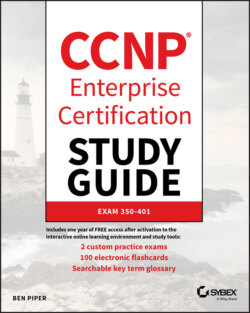Читать книгу CCNP Enterprise Certification Study Guide: Implementing and Operating Cisco Enterprise Network Core Technologies - Ben Piper, David Higby Clinton - Страница 53
Exam Essentials
ОглавлениеUnderstand why IP addresses and MAC addresses name interfaces, not nodes. An interface is bound to a subnet, and a node can have multiple interfaces. Other nodes in the same subnet can't determine whether any two MAC or IP addresses belong to the same node.
Know how switches extend a subnet across different physical media. Switches use flooding to forward broadcasts and unknown unicasts to all connected nodes in a given VLAN.
Understand how routers enable IP connectivity between subnets. When a router receives a layer 2 frame containing an IP packet, it decapsulates the packet and looks at the destination IP address. It checks its FIB to determine the next hop's IP address. If the next hop is reachable via Ethernet, it re-encapsulates the packet in an Ethernet frame addressed to the next-hop node's MAC address and forwards it. If the next hop is reachable via a PPP or HDLC connection, it encapsulates the IP packet in a PPP or HDLC frame and forwards it.
Know the encapsulation and decapsulation process for the protocols at each layer. With the exception of the Application layer, the PDU at each layer contains a reference to a protocol in the layer above. For example, an Ethernet frame contains a Type field that indicates a Network layer protocol, such as IPv4 (0x0800) or IPv6 (0x86DD). An IP packet contains a Protocol field indicating a Transport layer protocol, such as TCP (6) or UDP (17).
Understand the primary purpose of each layer. The Data Link layer facilitates data transfer between two nodes connected to a shared medium. The Network layer enables data transfer between nodes that may or may not be in the same subnet. The Transport layer facilitates application-to-application data transfer and provides error detection.
